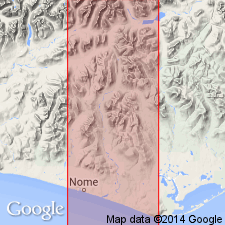
- Usage in publication:
-
- Tigaraha schist*
- Modifications:
-
- Named
- Dominant lithology:
-
- Schist
- AAPG geologic province:
-
- Seward Peninsula province
- Alaska West-Central region
Summary:
Named as uppermost formation of Kigluaik group for Tigaraha Mountain ("tigaraha" being Eskimo word for "pointed"), Grand Central quad, Seward Peninsula, AK, designated as type locality. Includes all that part of Kigluaik group between top of limestone of Mount Osborn and base of Nome group. Black graphitic beds of unit on south side of Kigluaik Mountains were considered by earlier workers to be part of Kuzitrin formation. Consists of brown-weathering biotite schist; upper part is siliceous graphitic schist, irregular in distribution and thickness. Thickness is several 1000 ft. Assigned to Paleozoic, possibly in part pre-Paleozoic.
Source: GNU records (USGS DDS-6; Menlo GNULEX).

- Usage in publication:
-
- Tigaraha Schist*
- Modifications:
-
- Age modified
- Areal extent
- AAPG geologic province:
-
- Seward Peninsula province
- Alaska West-Central region
Summary:
In Teller quad is composed of graphitic biotite schist, calcareous biotite schist, and biotite-garnet schist and several calcareous sequences. Graphitic schist on south side of Kigluaik Mountains (included by Moffit, 1913, in Tigaraha Schist) is here referred to "slate of the York region". Marble and calc-silicate rocks of unit are separately mapped from biotite-garnet schist. Age of Kigluaik Group is Precambrian based on geologic evidence and radiometric dating.
Source: GNU records (USGS DDS-6; Menlo GNULEX).
For more information, please contact Nancy Stamm, Geologic Names Committee Secretary.
Asterisk (*) indicates published by U.S. Geological Survey authors.
"No current usage" (†) implies that a name has been abandoned or has fallen into disuse. Former usage and, if known, replacement name given in parentheses ( ).
Slash (/) indicates name conflicts with nomenclatural guidelines (CSN, 1933; ACSN, 1961, 1970; NACSN, 1983, 2005, 2021). May be explained within brackets ([ ]).

